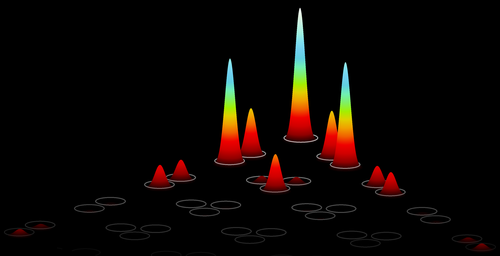“Among the many lessons that the past 18 months have taught all of us is that ‘shelter in place’ can be quite effective at protecting oneself from perilous circumstances,” remembers Dr. Matthias Heinrich, corresponding author of this groundbreaking work. Interestingly, a similar concept applies to light signals, which pass optical networks at great speed, but turn out to be surprisingly delicate entities.
Photonic topological insulators – artificial materials that conduct light along their edges, yet block it from traversing their interior – have fascinated group leader Prof. Alexander Szameit for a long time. “Ever since our first implementation of a topological insulator for light, we have strived to find ways how these peculiar systems can be best utilized,” the head of the solid-state optics group in Rostock remembers. Yet, while photonic topological insulators can ‘protect’ light propagating along precisely defined paths from scattering, their excellent resistance towards imperfections or external perturbations also poses fundamentals challenges.
“There simply is no ‘stop’-sign for photons,” lead author Marco S. Kirsch outlines the point of origin of his experiments, “and topologically protected light will easily evade any of the ‘road blocks’ one might employ for conventional optical systems.” The solution that the young physicist came up with in the course of his bachelor thesis was to create dedicated ‘rest areas’ that allow for light to remain localized without ever exiting the topological circuit: Corner states in so-called ‘higher-order topological insulators,’ or HOTIs.
In close collaboration with theorists from the University of Rostock, the ICFO in Barcelona, the University of Lisbon and the Institute of Spectroscopy of Russian Academy of Sciences, the team of researchers leveraged nonlinear optical effects to enable the necessary crosstalk between localized and propagating topological states. “In essence, we found a way to use this nonlinearity as ‘turn signal’ for light to enter or leave these corner states, and to thereby continue its intended route”, elaborates Kirsch. Despite the added difficulties of the pandemic, a year of intense research and countless hours in the labs of the Institute of Physics at the University Rostock, not only yielded the material for an excellent Bachelor’s thesis, but also earned the aspiring young physicist a publication in one of the most prestigious scientific journals in the field.
The successful international collaboration has substantially advanced fundamental research on nonlinear topological photonics. While several formidable challenges remain until these insights will find their way into consumer products, the physicists’ newest discovery has great potential for a wide range of innovative applications such as topologically protected all-optical signal processing and self-improving photonic neuronal nets. Given the rapid pace of progress driven by keen minds from the next generation of researchers, these ideas could soon become reality.
This research was funded by Deutsche Forschungsgemeinschaft and the Alfried Krupp von Bohlen und Halbach-Foundation.
The original publication in “Nature Physics” is available under DOI: 10.1038/s41567-021-01275-3 (https://www.nature.com/articles/s41567-021-01275-3)
Contact:
Dr. Matthias Heinrich
Experimental Solid-State Optics Group
Institute for Physics
University of Rostock
Tel.: +49 381 498-6796
E-Mail: matthias.heinrichuni-rostockde

